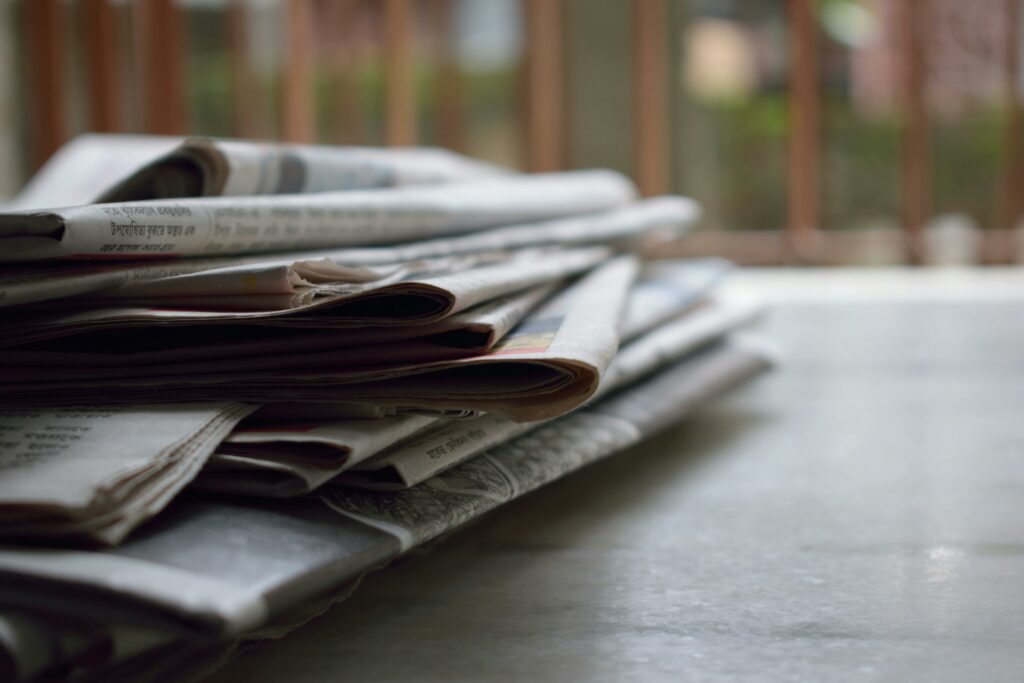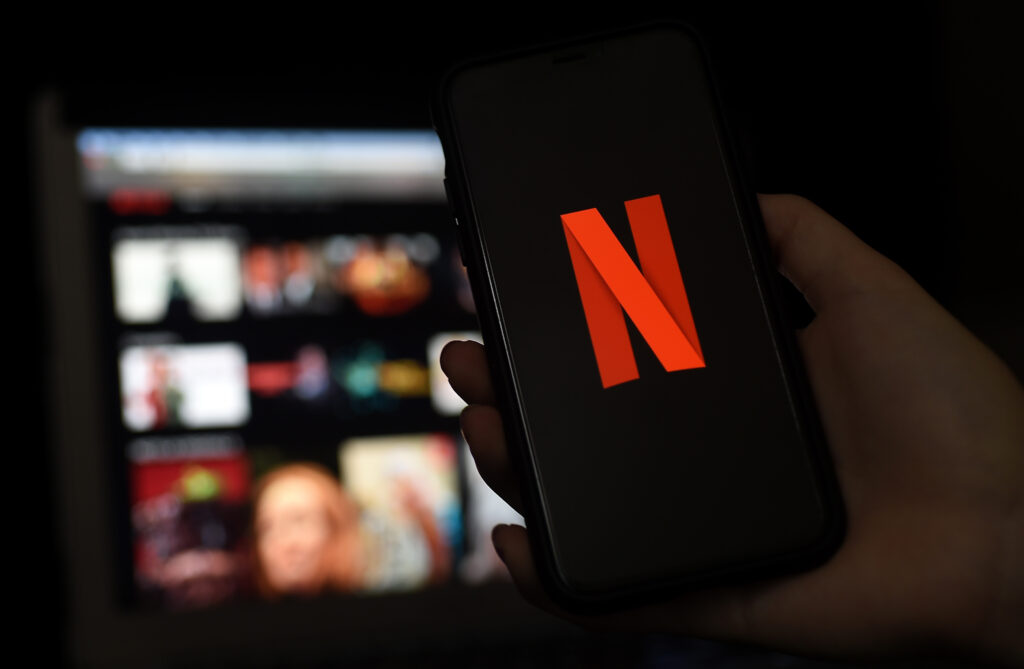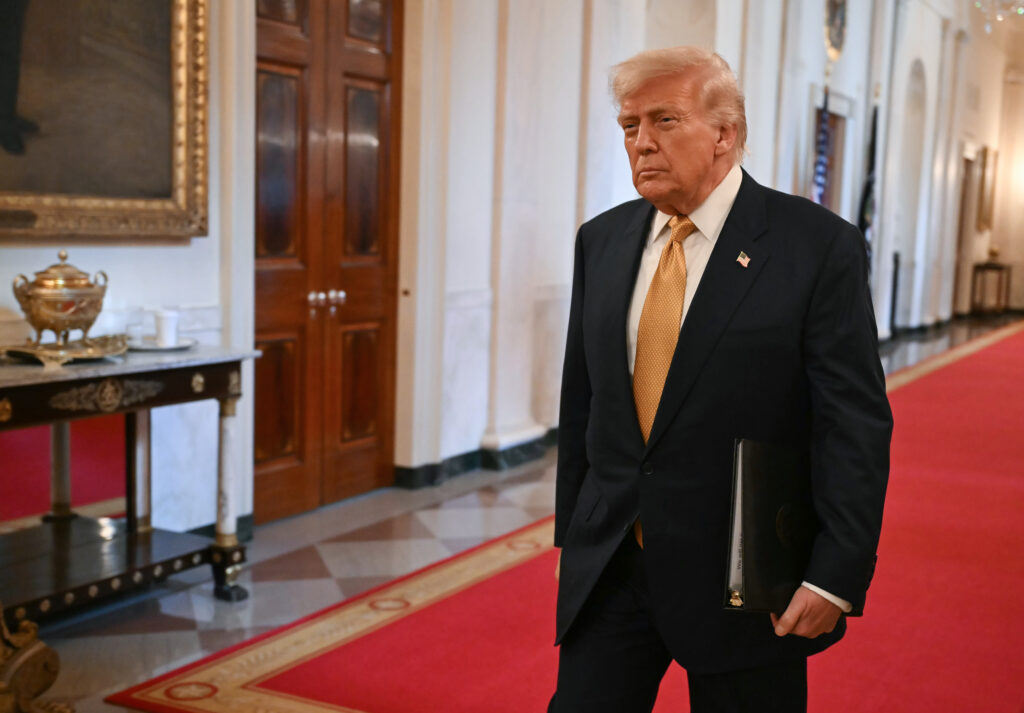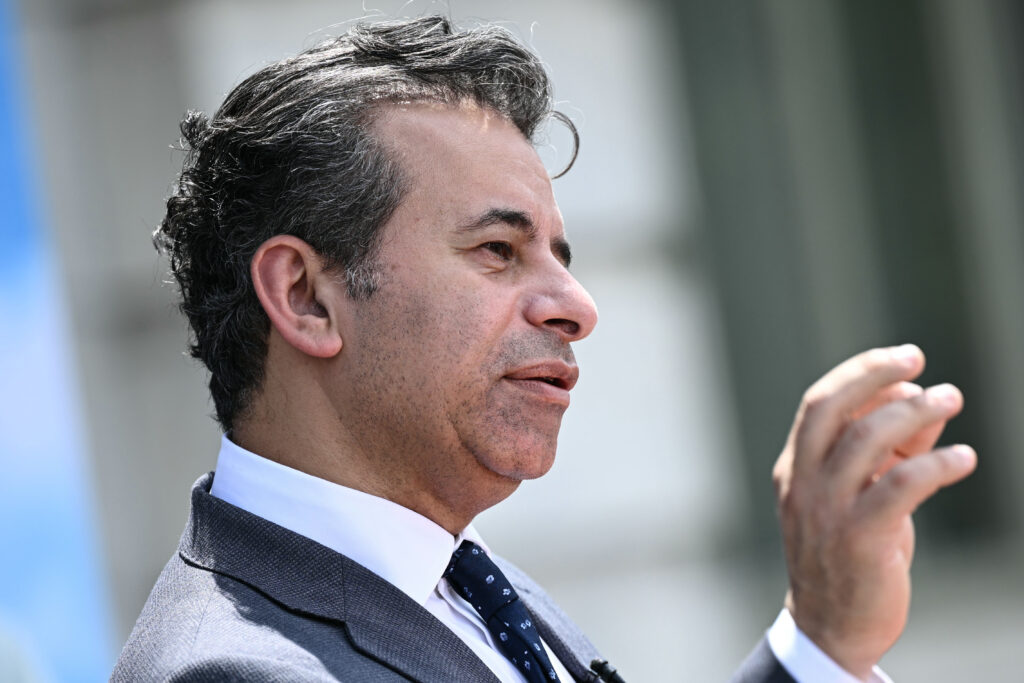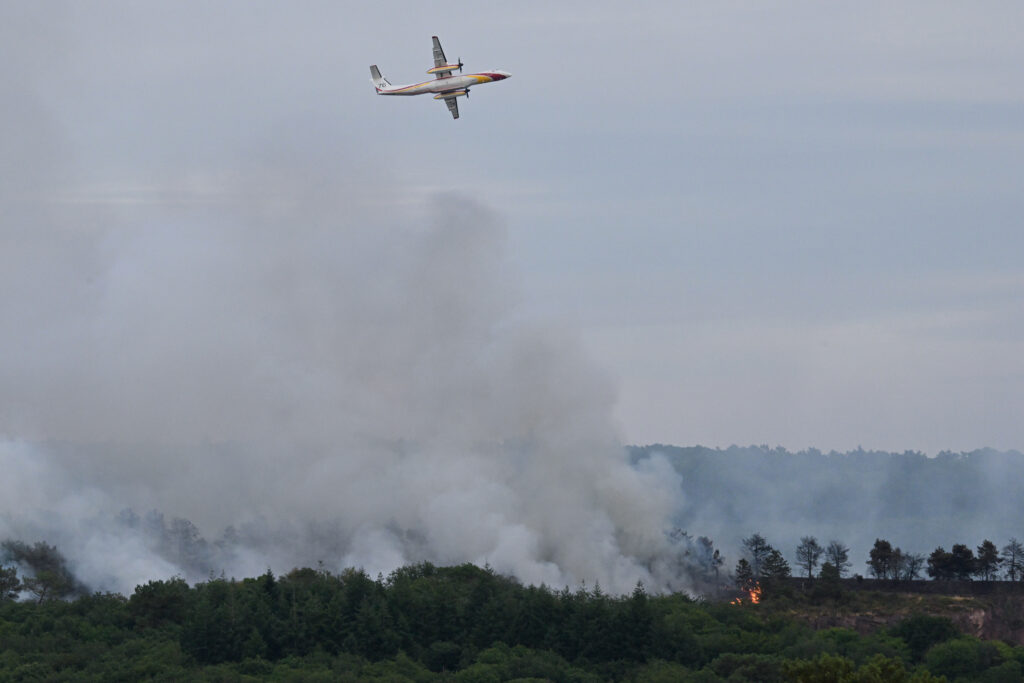Euro-2025: les Anglaises, invincibles, filent en demi-finale
Au bout d’un match dingue et d’une séance de tirs au but interminable, les Anglaises, championnes d’Europe en titre, portées par l’entrée de Chloé Kelly, ont réussi à renverser un match en deux minutes alors qu’elles étaient dominées dans tous les secteurs de jeu.L’Angleterre peut remercier sa gardienne Hannah Hampton, qui a sorti au moins quatre tirs au but suédois au bout d’une séance interminable, après une prolongation où il ne s’est pas passé grand chose. Seules Lucy Bronze, Chloé Kelly et Alessia Russo ont transformé leur tir.Les joueuses de Sarina Wiegman restent donc invincibles même si ce quart de finale semblait devoir aboutir à un succès facile des Suédoises. Dès le début du match, les jaunes et bleues, poussées par les “Soft Hooligans” venus en nombre avec chants, tambours et inclusion, avaient complètement surclassé les coéquipières de Leah Williamson, méconnaissables et fragiles.En encaissant un but dès la 2e minute par la milieu de 35 ans Kosovare Asllani puis par Stina Blackstenius (25e), les Anglaises ont complètement sombré défensivement à l’image de Jess Carter, fautive sur les deux buts. Les Suédoises ont ensuite déroulé avant d’être moins incisives en seconde période.Après avoir perdu (2-1) contre la France lors de leur entrée en lice avant de se réveiller contre les Pays-Bas (4-0) puis face aux Pays de Galles (6-1), les Anglaises semblaient en panne physiquement, absentes dans les duels, face à des Suédoises qui impressionnaient comme depuis le début de cet Euro.Mais l’entrée de Chloé Kelly, buteuse déjà lors de la finale victorieuse en 2022, a tout changé. En deux minutes, elle a renversé la situation, réveillant les supporters anglais du stade de Zurich (22.400). La remplaçante a fait mieux en deux minutes que sur la totalité du match des attaquantes vedettes Alessia Russo ou Lauren James, très peu en vue.- Kelly, décisive -Sur son premier ballon, l’ailière – rentrée à la 78e minute – a servi Lucy Bronze au second poteau, laissée étrangement seule par la défense suédoise (2-1, 79e).Dans la foulée, sur son deuxième ballon, Chloé Kelly a centré de nouveau de la gauche, cette fois pour la jeune Michelle Agyemang (2-2, 81e). Rentrée dix minutes avant et n’ayant joué que cinq minutes contre la France, l’attaquante d’Arsenal âgée de 19 ans et qui a peu connu l’équipe A a changé le destin des championnes d’Europe en titre, qui peuvent aussi remercier leur gardienne de les avoir sauvée à deux reprises. En fin de match, Hannah Hampton, qui a fini les prolongations avec le nez en sang, a sorti deux arrêts décisifs (88e) avec les poings sur une frappe suédoise et juste avant la mi-temps (45+1) pour éviter le pire.A la poursuite d’un premier titre majeur depuis leur victoire lors du premier Euro féminin en 1984, les Suédoises ont été brutalement arrêtées dans leur course, alors qu’elles faisaient partie des favorites.Les Anglaises vont maintenant affronter les Italiennes en demi-finale le 22 juillet à Genève.
Les profits de Netflix bondissent grâce aux hausses de prix des abonnements
Netflix a vu son bénéfice net bondir de 45% à 3,125 milliards de dollars au deuxième trimestre, un signe que les hausses de prix et l’offre publicitaire sont de plus en plus payantes pour la plateforme leader du streaming vidéo.Le chiffre d’affaires du groupe américain est ressorti à 11,1 milliards, en progression de 16% sur un an, un chiffre supérieur à ses prévisions et à celles du marché, d’après son communiqué de résultats publié jeudi.Netflix a systématiquement dépassé les attentes du marché ces deux dernières années, y compris au premier trimestre 2025 grâce notamment aux augmentations des prix des abonnements.L’entreprise a revu ses prévisions à la hausse pour l’année 2025, tablant désormais sur des revenus compris entre 44,8 et 45,2 milliards, au lieu d’une fourchette entre 43,5 et 44,5 milliards.Cette nouvelle perspective “reflète principalement l’affaiblissement du dollar par rapport aux autres devises, ainsi qu’une croissance solide du nombre d’abonnés et des recettes publicitaires”, a-t-elle précisé.”Au-delà de la question de savoir si Netflix peut maintenir cette dynamique positive, les investisseurs vont surveiller de près ses récentes incursions dans le sport et la télévision en direct”, a commenté Paul Verna, analyste d’Emarketer.- “Elargir l’offre” -Fin 2024, la plateforme a diffusé en direct deux matchs de la ligue professionnelle de football américain NFL et un match de boxe entre Mike Tyson et le YouTubeur Jake Paul.En juin, la société californienne a signé un accord avec TF1, leader des audiences en France, pour diffuser les chaînes du groupe sur le service, une première mondiale.”On pourrait croire que nous avons assez de contenus incroyables pour satisfaire chaque personne sur la planète, mais il semblerait que nos abonnés veulent toujours plus de variété, c’est ce qu’on entend régulièrement”, a plaisanté le codirecteur général Greg Peters lors de la conférence aux analystes jeudi.”Donc le but fondamental de ce partenariat, c’est d’élargir notre offre de divertissement”, a-t-il ajouté.Netflix a ensuite conclu un partenariat avec l’Agence spatiale américaine, la Nasa, qui permettra bientôt aux utilisateurs de suivre les lancements de fusées et les mouvements d’astronautes dans l’espace.La plateforme comptait plus de 300 millions d’abonnés en décembre dernier, à la fin d’une saison des fêtes particulièrement réussie, où elle venait de gagner près de 19 millions de nouveaux abonnements.Mais l’entreprise ne divulgue plus ces chiffres désormais, afin de se concentrer sur les mesures “d’engagement” de l’audience (temps passé à regarder des contenus).- “Leader incontesté” -Au deuxième semestre, Netflix pourra compter notamment sur une nouvelle saison de “Mercredi” et la dernière de “Stranger Things” pour capter l’attention de ses membres.”Nous avons eu 44 titres nominés aux Emmys cette année. Ca, c’est de la qualité à grande échelle”, s’est félicité Ted Sarandos, l’autre codirecteur général de l’entreprise.Des contenus qui coûtent de plus en plus cher: Netflix prévoit une augmentation de ses dépenses pour la production et l’achat de contenus, sans entamer ses marges opérationnelles.L’engagement constitue un indicateur important pour l’abonnement avec publicité, dont la base d’utilisateurs a plus que doublé début 2025 par rapport à l’année précédente, selon Emarketer. Le service table sur 9 milliards de dollars de revenus tirés de cette formule d’ici 2030.Et pour toujours mieux optimiser l’engagement, Netflix teste depuis peu un outil d’intelligence artificielle (IA) générative qui permet aux abonnés de décrire ce dont ils ont envie en langage courant. Par exemple: “Je veux voir quelque chose d’effrayant, mais pas trop, et un peu drôle aussi”.”A ce stade, il ne fait aucun doute que Netflix est le leader incontesté du streaming haut de gamme”, souligne l’analyste Paul Verna. “Wall Street va donc s’intéresser davantage à sa capacité à faire croître son activité qu’à savoir s’il gagne la guerre du streaming ou non. (La réponse est oui.)”
Les profits de Netflix bondissent grâce aux hausses de prix des abonnements
Netflix a vu son bénéfice net bondir de 45% à 3,125 milliards de dollars au deuxième trimestre, un signe que les hausses de prix et l’offre publicitaire sont de plus en plus payantes pour la plateforme leader du streaming vidéo.Le chiffre d’affaires du groupe américain est ressorti à 11,1 milliards, en progression de 16% sur un an, un chiffre supérieur à ses prévisions et à celles du marché, d’après son communiqué de résultats publié jeudi.Netflix a systématiquement dépassé les attentes du marché ces deux dernières années, y compris au premier trimestre 2025 grâce notamment aux augmentations des prix des abonnements.L’entreprise a revu ses prévisions à la hausse pour l’année 2025, tablant désormais sur des revenus compris entre 44,8 et 45,2 milliards, au lieu d’une fourchette entre 43,5 et 44,5 milliards.Cette nouvelle perspective “reflète principalement l’affaiblissement du dollar par rapport aux autres devises, ainsi qu’une croissance solide du nombre d’abonnés et des recettes publicitaires”, a-t-elle précisé.”Au-delà de la question de savoir si Netflix peut maintenir cette dynamique positive, les investisseurs vont surveiller de près ses récentes incursions dans le sport et la télévision en direct”, a commenté Paul Verna, analyste d’Emarketer.- “Elargir l’offre” -Fin 2024, la plateforme a diffusé en direct deux matchs de la ligue professionnelle de football américain NFL et un match de boxe entre Mike Tyson et le YouTubeur Jake Paul.En juin, la société californienne a signé un accord avec TF1, leader des audiences en France, pour diffuser les chaînes du groupe sur le service, une première mondiale.”On pourrait croire que nous avons assez de contenus incroyables pour satisfaire chaque personne sur la planète, mais il semblerait que nos abonnés veulent toujours plus de variété, c’est ce qu’on entend régulièrement”, a plaisanté le codirecteur général Greg Peters lors de la conférence aux analystes jeudi.”Donc le but fondamental de ce partenariat, c’est d’élargir notre offre de divertissement”, a-t-il ajouté.Netflix a ensuite conclu un partenariat avec l’Agence spatiale américaine, la Nasa, qui permettra bientôt aux utilisateurs de suivre les lancements de fusées et les mouvements d’astronautes dans l’espace.La plateforme comptait plus de 300 millions d’abonnés en décembre dernier, à la fin d’une saison des fêtes particulièrement réussie, où elle venait de gagner près de 19 millions de nouveaux abonnements.Mais l’entreprise ne divulgue plus ces chiffres désormais, afin de se concentrer sur les mesures “d’engagement” de l’audience (temps passé à regarder des contenus).- “Leader incontesté” -Au deuxième semestre, Netflix pourra compter notamment sur une nouvelle saison de “Mercredi” et la dernière de “Stranger Things” pour capter l’attention de ses membres.”Nous avons eu 44 titres nominés aux Emmys cette année. Ca, c’est de la qualité à grande échelle”, s’est félicité Ted Sarandos, l’autre codirecteur général de l’entreprise.Des contenus qui coûtent de plus en plus cher: Netflix prévoit une augmentation de ses dépenses pour la production et l’achat de contenus, sans entamer ses marges opérationnelles.L’engagement constitue un indicateur important pour l’abonnement avec publicité, dont la base d’utilisateurs a plus que doublé début 2025 par rapport à l’année précédente, selon Emarketer. Le service table sur 9 milliards de dollars de revenus tirés de cette formule d’ici 2030.Et pour toujours mieux optimiser l’engagement, Netflix teste depuis peu un outil d’intelligence artificielle (IA) générative qui permet aux abonnés de décrire ce dont ils ont envie en langage courant. Par exemple: “Je veux voir quelque chose d’effrayant, mais pas trop, et un peu drôle aussi”.”A ce stade, il ne fait aucun doute que Netflix est le leader incontesté du streaming haut de gamme”, souligne l’analyste Paul Verna. “Wall Street va donc s’intéresser davantage à sa capacité à faire croître son activité qu’à savoir s’il gagne la guerre du streaming ou non. (La réponse est oui.)”
Trump souffre d’insuffisance veineuse, après avoir fait état de jambes enflées
Donald Trump souffre d’insuffisance veineuse chronique, a annoncé jeudi la Maison Blanche, après que le président américain de 79 ans a fait état de “légers gonflements du bas de ses jambes”, une pathologie courante à son âge.Des examens “approfondis” ont révélé ce problème circulatoire, qui entraîne une accumulation de sang dans les membres inférieurs.La porte-parole de la Maison Blanche, Karoline Leavitt, a qualifié cette affection de “bénigne et courante, particulièrement chez les individus de plus de 70 ans”, avant de préciser qu’aucune “thrombose veineuse profonde ou de maladie artérielle” n’avait été découverte.Spécialiste de médecine interne à Tucson (Arizona), Matt Heinz confirme à l’AFP que l’insuffisance veineuse chronique est “assez courante” en particulier chez les sujets âgés. Elle résulte d’une moindre efficacité des valvules veineuses, qui servent à rediriger le sang vers le coeur, en raison du vieillissement, d’obésité ou d’inactivité, explique-t-il.S’il “ne veu(t) pas dire que ce n’est rien du tout”, “son cas ne semble pas nécessiter de traitements invasifs”, comme le remplacement chirurgical de valves, estime le médecin hospitalier.”Il est plutôt question de bas de contention, d’activité, et peut-être de perdre un peu plus de poids”, conseille Matt Heinz. “Plus d’activité ne veut pas dire rouler en voiturette de golf, ça veut dire marcher”, souligne-t-il.Tous les résultats des examens de Donald Trump “étaient dans les normes” et “le président demeure en excellente santé”, a insisté Karoline Leavitt.- Ecchymoses -La porte-parole de la Maison Blanche a également répondu aux spéculations grandissantes sur les réseaux sociaux autour d’un éventuel problème de santé du président républicain, après la publication de photos montrant des ecchymoses sur ses mains.Selon elle, elles sont la conséquence associée “de fréquentes poignées de mains” et de sa prise d’aspirine, “dans le cadre d’une prescription préventive cardiovasculaire standard”.En janvier, Donald Trump était devenu le plus vieux président à entrer en fonction de l’histoire des Etats-Unis, remplaçant Joe Biden, qui avait quitté le pouvoir à 82 ans.Le milliardaire républicain se vante fréquemment d’être “en pleine forme” et ses services ont même publié récemment une image le montrant en Superman.En avril, l’équipe médicale de la Maison Blanche l’avait décrit comme en “excellente santé cognitive et physique” après sa première visite médicale depuis son retour au pouvoir.Donald Trump accuse régulièrement l’entourage de Joe Biden, qui l’avait battu en 2020, d’avoir cherché à masquer le déclin du président démocrate octogénaire.Joe Biden s’était retiré tardivement de la course à la présidentielle de 2024, sur fond d’inquiétudes quant à son état de santé après un débat calamiteux face à Donald Trump.En mai, un cancer de la prostate a été diagnostiqué à l’ancien président démocrate.dk-ia-rle-es/cyb/vla
US may revise hormone replacement therapy warnings
US Food and Drug Administration Commissioner Marty Makary signaled Thursday that he is open to revising strict warning labels on Hormone Replacement Therapy, following testimony from experts who said the treatment’s risks have long been exaggerated.HRT is taken to replace estrogen the body stops producing after menopause — when periods end permanently — and helps relieve symptoms such as hot flashes, vaginal discomfort, and pain during sex.But its use has plummeted in recent years amid concerns including a possible link to invasive breast cancer.Food and Drug Administration (FDA) chief Marty Makary, who convened Thursday’s meeting of outside experts, told AFP: “We have to revisit these topics.”He argued that the framework that led to so-called “black box warnings” — the strongest warning the FDA can require for prescription drugs — “came from a different era.” “Not only is there no clinical trial showing an increase in breast cancer mortality, but there are also other tremendous long term health benefits,” Makary added.The 12 experts convened by the agency said HRT’s benefits go beyond easing menopausal symptoms. They cited evidence for reduced fracture risk, improved cardiovascular and cognitive health, and fewer urinary tract infections.”Estrogen is the only well-established intervention to reduce the frequency of osteoporotic fracture in postmenopausal women, to the tune of 30 to 50 percent,” said Vonda Wright, an orthopedic surgeon at the University of Central Florida.Roberta Diaz Brinton, director of the Center for Innovation in Brain Science, said her research suggests the reason two-thirds of people globally with Alzheimer’s are women is not because they live slightly longer than men, but because the disease begins during the menopausal transition.”Depending upon when hormone therapy is introduced… there’s a significant reduction in risk of developing Alzheimer’s disease,” she said.The University of Arizona researcher linked menopause to a drop in the brain’s ability to metabolize glucose and a rise in protein plaque deposits.Panelists blamed the collapse in HRT use on the Women’s Health Initiative (WHI), a landmark clinical trial halted in 2002 after flagging a possible increased breast cancer risk — findings they say were misinterpreted.”Prescriptions for hormone replacement therapy plummeted in the United States, women flushed their pills down the toilet,” Makary said in his opening remarks, mentioning his own mother’s experience of multiple bone fractures in old age.Critics of the WHI argue it included participants well past menopause — when risks are higher and benefits lower — and used outdated formulations no longer common today.- Label changes -Still, the issue remains divisive within the medical community.HRT can be administered through various means including orally, through skin patches, or vaginally; and is given either as estrogen alone or with progesterone.The FDA’s own warning label for it cites risks including endometrial cancer, breast cancer, and life-threatening blood clots.Adriane Fugh-Berman, who directs a project that promotes rational prescribing at Georgetown University, attended as an observer and criticized the lack of dissenting voices.”This was a very one-sided panel of people who are all proponents of hormone therapy and who seem to have a very poor understanding of the evidence,” she told AFP.”While hormones can be a useful treatment for severe menopausal symptoms, they should not be used for chronic disease prevention,” she added, noting that no randomized clinical trial — the gold standard of evidence — has found HRT beneficial for cognition or dementia prevention.She also said that after the WHI findings were released, hormone use fell globally — and breast cancer rates dropped across registries tracking them.Several of the panelists had ties to companies offering menopause treatments or are affiliated with the advocacy group “Let’s Talk Menopause,” which receives pharmaceutical funding and campaigns to revise FDA warning labels.
Bretagne: l’incendie dans la forêt de Brocéliande est fixé
L’important incendie qui s’est déclaré jeudi après-midi en forêt de Brocéliande à l’ouest de Rennes, détruisant une centaine d’hectares de végétation, était fixé en fin de soirée, a annoncé la préfecture d’Ille-et-Vilaine.”A 23h30, le feu est fixé”, a indiqué la préfecture dans un communiqué publié vers minuit. “120 hectares de végétation ont déjà brûlé”, avait-elle précisé quelques heures plus tôt sur le réseau X.Au total, plus de 335 pompiers venus du Morbihan et d’Ille-et-Vilaine, de nombreux moyens terrestres ainsi notamment que deux avions bombardiers d’eau, un Air Tractor et un Dash 8, ont été mobilisés.”A l’heure où je vous parle, le feu est fixé, c’est-à-dire que nous avons stoppé sa progression”, a expliqué le lieutenant-colonel Patrice Feneon, du SDIS d’Ille-et-Vilaine, interrogé en fin de soirée par plusieurs médias sur place. “Nous allons passer la nuit à éteindre tous les foyers que nous identifions avec des drones notamment”.Le feu s’est déclaré vers 16h00 sur la commune de Tréhorenteuc (Morbihan), à une soixantaine de kilomètres à l’ouest de Rennes. Il s’est ensuite propagé en direction nord/nord-est avant de toucher principalement la commune de Paimpont en Ille-et-Vilaine.”La propagation du feu est facilitée par la sécheresse de la végétation et des vents marqués”, a affirmé la préfecture, précisant que “les renforts aériens, Air Tractor et Dash 8, sont arrivés et ont commencé les largages sur le site de l’incendie”. Ces largages ont été interrompus avec la nuit.Le pélicandrome (lieu de ravitaillement en eau ou en produit retardant pour les avions bombardiers d’eau, ndlr) de Vannes Meucon a été activé.Aucune habitation n’a été menacée, selon la préfecture d’Ille-et-Vilaine.Mais plusieurs routes départementales ont été coupées et il est demandé à la population d’éviter le secteur et de faciliter l’accès des secours.Suite à cet incendie, la préfecture d’Ille-et-Vilaine a lancé un appel à la prudence et pris un arrêté d’interdiction temporaire d’accès des massifs boisés et landes des communes à risque jusqu’à vendredi soir.La forêt de Brocéliande, très prisée des touristes en cette période de l’année, avait connu de très importants incendies en août 2022. Quelque 400 hectares de la forêt de Merlin l’enchanteur avaient été détruits par les flammes.Cette forêt, qui s’étend sur plus de 9.000 hectares, est un haut-lieu de la légende arthurienne, à cheval sur l’est du Morbihan et le sud-ouest de l’Ille-et-Vilaine.
Bretagne: l’incendie dans la forêt de Brocéliande est fixé
L’important incendie qui s’est déclaré jeudi après-midi en forêt de Brocéliande à l’ouest de Rennes, détruisant une centaine d’hectares de végétation, était fixé en fin de soirée, a annoncé la préfecture d’Ille-et-Vilaine.”A 23h30, le feu est fixé”, a indiqué la préfecture dans un communiqué publié vers minuit. “120 hectares de végétation ont déjà brûlé”, avait-elle précisé quelques heures plus tôt sur le réseau X.Au total, plus de 335 pompiers venus du Morbihan et d’Ille-et-Vilaine, de nombreux moyens terrestres ainsi notamment que deux avions bombardiers d’eau, un Air Tractor et un Dash 8, ont été mobilisés.”A l’heure où je vous parle, le feu est fixé, c’est-à-dire que nous avons stoppé sa progression”, a expliqué le lieutenant-colonel Patrice Feneon, du SDIS d’Ille-et-Vilaine, interrogé en fin de soirée par plusieurs médias sur place. “Nous allons passer la nuit à éteindre tous les foyers que nous identifions avec des drones notamment”.Le feu s’est déclaré vers 16h00 sur la commune de Tréhorenteuc (Morbihan), à une soixantaine de kilomètres à l’ouest de Rennes. Il s’est ensuite propagé en direction nord/nord-est avant de toucher principalement la commune de Paimpont en Ille-et-Vilaine.”La propagation du feu est facilitée par la sécheresse de la végétation et des vents marqués”, a affirmé la préfecture, précisant que “les renforts aériens, Air Tractor et Dash 8, sont arrivés et ont commencé les largages sur le site de l’incendie”. Ces largages ont été interrompus avec la nuit.Le pélicandrome (lieu de ravitaillement en eau ou en produit retardant pour les avions bombardiers d’eau, ndlr) de Vannes Meucon a été activé.Aucune habitation n’a été menacée, selon la préfecture d’Ille-et-Vilaine.Mais plusieurs routes départementales ont été coupées et il est demandé à la population d’éviter le secteur et de faciliter l’accès des secours.Suite à cet incendie, la préfecture d’Ille-et-Vilaine a lancé un appel à la prudence et pris un arrêté d’interdiction temporaire d’accès des massifs boisés et landes des communes à risque jusqu’à vendredi soir.La forêt de Brocéliande, très prisée des touristes en cette période de l’année, avait connu de très importants incendies en août 2022. Quelque 400 hectares de la forêt de Merlin l’enchanteur avaient été détruits par les flammes.Cette forêt, qui s’étend sur plus de 9.000 hectares, est un haut-lieu de la légende arthurienne, à cheval sur l’est du Morbihan et le sud-ouest de l’Ille-et-Vilaine.
US House passes landmark crypto measures in win for Trump
The US House of Representatives on Thursday passed three landmark cryptocurrency bills, fulfilling the Trump administration’s commitment to the once-controversial industry.Lawmakers easily approved the CLARITY Act, which aims to establish a clearer regulatory framework for cryptocurrencies and other digital assets. The bill is designed to clarify industry rules and divide regulatory authority between the Securities and Exchange Commission (SEC) and the Commodity Futures Trading Commission (CFTC). It will now advance to the Senate, where Republicans hold a slim majority.House legislators also readily passed the GENIUS Act, which codifies the use of stablecoins — cryptocurrencies pegged to stable assets like the US dollar or US bonds. This bill is expected to go directly to President Trump for his signature to become law. The Senate passed the GENIUS Act last month, and it sets requirements such as mandating that issuers hold reserves of assets equal in value to their outstanding cryptocurrency.”This historic legislation will bring our payment system into the 21st century. It will ensure the dominance of the US dollar. It will increase demand for US Treasuries,” said Senator Bill Hagerty, the measure’s sponsor in the Senate.This wave of legislation follows years of skepticism towards crypto, driven by the belief that the sector, born from bitcoin’s success, should be tightly controlled and kept separate from mainstream investors. However, after crypto investors contributed millions of dollars to his presidential campaign last year, Trump reversed his previous doubts about the industry. He even launched a Trump meme coin and other ventures as he prepared for his return to the White House and hosted a gala dinner for the coin’s top buyers once he was in office.And according to the Financial Times, Trump is now preparing to open the $9 trillion US retirement market to cryptocurrency investments as well as gold, and private equity.Notably, both the CLARITY Act and the GENIUS Act garnered significant bipartisan support, with Democrats also having seen an increase in lobbying and contributions from the crypto industry. “It’s critically important we bring more certainty to the marketplace with clear rules of the road,” said congressman Josh Gottheimer, a Democrat who supported the bills.Since taking office, Trump has made several moves to support the crypto sector, including appointing crypto advocate Paul Atkins to lead the SEC. He also established a federal “Strategic Bitcoin Reserve” to audit the government’s bitcoin holdings, primarily accumulated through law enforcement’s judicial seizures. Forbes magazine estimates that the president’s foray into the crypto business has doubled his wealth to $5.3 billion in just one year.In a largely partisan vote, the Republican-led House also passed the Anti-CBDC Surveillance State Act. It aims to block the issuance of a central bank digital currency (CBDC) — a digital dollar issued by the US Federal Reserve — even if there currently are no plans for such an endeavor. Republicans argue that a CBDC could enable the federal government to monitor, track, and potentially control private citizens’ financial transactions, thereby undermining privacy and civil liberties.Passage of this measure in the Senate is far from guaranteed before it can go to the president’s desk. An earlier attempt to set aside the anti-CBDC bill caused a significant stir among a small group of Republicans and delayed passage of the other two bills until eleventh-hour lobbying by Trump helped resolve the issue.
